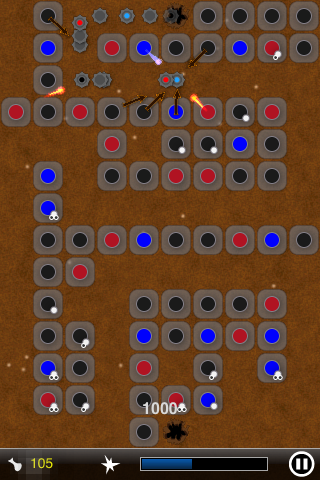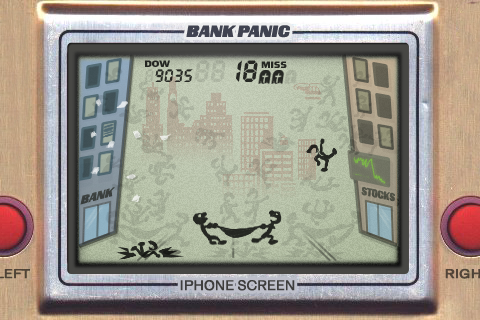Notes From Under the iPhone Underground
The iTunes App Store recently achieved over 10,000 apps on offer. According to AppShopper.com, about 24% of those apps are games. That means there are lots and lots of games available for the iPhone. Like over 2000 titles. For comparison’s sake, Wikipedia lists 950 original Xbox titles. The iPhone is already a more prolific gaming platform than entire generations of previous hardware, a fact that has propelled the platform into the mainstream of mobile gaming, which is itself a little-known underground of actual mainstream gaming. The iPhone can arguably be called the first gaming platform with mobile phone capabilities.
Two things are completely true when it comes to iPhone games: 1) Most of them suck. Sturgeon’s Law comes into play big time on this platform. 2) It is a complete pain to discover which games don’t suck.
Sure, it’s easy to discover Fieldrunners or SimCity, but the iTunes App Store is woefully inadequate when it comes to highlighting interesting games. In spite of being one of the most prolific platforms around, there are few blogs, magazines, podcasts or TV shows that cover iPhone games. It is a crowded underground, seething with life, but not well-known.
Fortunately, sites like Touch Arcade and Finger Gaming have been stepping in to help us get to know iPhone gaming. The effort to inform the masses about the great things happening in iPhone game development is a noble one. I believe in it so much that I want to throw in with them and highlight two games that I have discovered deep in the underground of the iPhone gaming underground. The two examples I’ve chosen today represent opposite poles of the ludological spectrum. Mote Massacre is an open source tower defense game dedicated to quality play above all else, while Bank Panic is a profound one-liner that succeeds in ways most games don’t even attempt.

Mote Massacre 2008 Grant Jones
Grant Jones developed the first, as far as I know, tower defense game for the iPhone. His game, Mote Massacre (or Mote-M, as the cool kids say), quickly gained a following although it has never been prominently featured in the App Store lists. Mote-M costs 99 cents, and it always has, but after Apple lifted the NDA preventing developers from discussing or sharing iPhone code Mr. Jones decided to open source the game. Again blazing an indy trail, Mote-M became one of, if not the, first iPhone games to release its full source code (discounting, of course, all the iPhone games that are ported from open source projects).
Mote-M is a “desktop” or open style of tower defense, where the towers the player builds form the maze that the baddies must traverse. Strategy is key in designing your maze, but so is luck since Mote-M layers on an aspect of chance in the form of randomly appearing free upgrade opportunities. Although the graphics are not much to brag on, the game-play is super solid and the online high scores leaderboard has kept me coming back to defend my honor. This is one not to miss, especially for fans of the tower defense genre. And for any budding iPhone developers, the source code is well worth checking out.
While the focus on game-play in Mote-M is well taken, sometimes a game doesn’t need to become part of the daily routine in order to be an excellent work. Bank Panic is an example of how the iTunes App Store and iPhone software model can support works of art as well as works of productivity.

Bank Panic 2009 Codeon Communications GmbH
Codeon Communications GmbH have created a timely art game called Bank Panic. The game looks like a classic LCD style handheld game, complete with residual images showing where the figures can move. The player has two buttons: move left and move right. The player controls two firemen with a rescue blanket who must catch bankers who are plummeting from the windows. As the game’s website explains, Bank Panic checks the status of the Dow Jones at the beginning of each game and modulates the difficulty based on how poorly the markets are doing. A falling market causes more bankers to jump, increasing the difficulty of the game.
Bank Panic is less a game than an art experience. Contextualizing the economic collapse in an old-fashioned LCD game makes it seem quaint and almost enjoyable. The morbidity of the Dow Jones integration also highlights a certain schadenfreude inherent in watching the ultra-rich beg for financial help on the nightly news. (I mean, c’mon, who doesn’t take a little glee seeing the heads of Detroit’s “Big Three” get chastised by a government panel? That’s good TV!) This mixture of comedy, tragedy, and the pressures of history elicits the sort of reaction that can only be achieved by a good game. That is also sort of effect that unsettles those who do not understand games, which boosts Bank Panic’s under-underground street cred.
Taken together, these two titles offer a glimpse into the great variety of game content available now for the iPhone. As developers share code and influence each other with bold concepts, the iPhone gaming platform is clearly set for great things. As recent consumer electronics shows have proven, other phones offer similar snazzy hardware and featuers, but it is the end-to-end software development and distribution model of the iTunes App Store that has given the iPhone such a great lead over its competitors. And within the iTunes App Store, games have been a driving force.
January 15th, 2009 at 10:42 pm
“The iTunes App Store recently achieved over 10,000 apps on offer. ”
It more recently achieved over 15,000 apps on offer. We’re tracking 15,434.
Justin Noel
January 16th, 2009 at 12:27 am
Thanks for the update. The rate of growth is amazing!
January 16th, 2009 at 2:36 am
oh, i am definitely going to be playing Bank Panic. thanks for the heads-up. keep letting me know if i should bother looking through the app store. i kind of hate that place.
January 16th, 2009 at 4:36 am
I adore the design of Bank Panic, especially the metal embossing around the LCD screen. The little detail of the small dent (to the right of the screen) is especially endearing. Clearly the art director(s) carried and dropped his/her fair share of these handheld games in the early 80s.